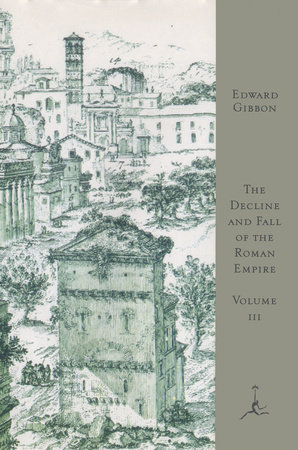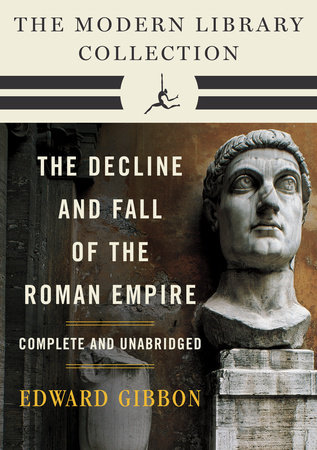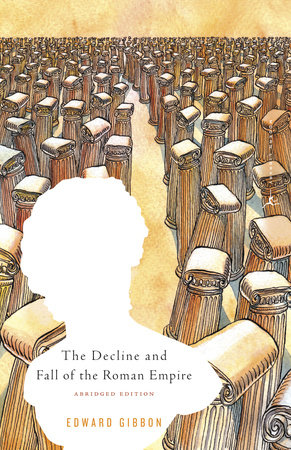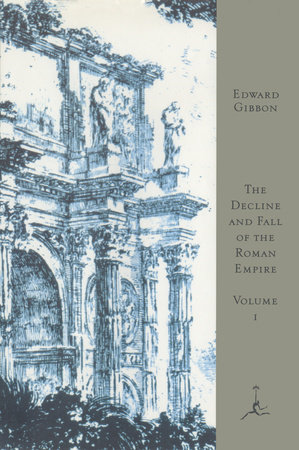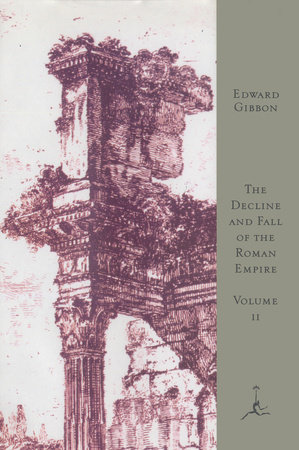Excerpt
The Decline and Fall of the Roman Empire, Volume III
INTRODUCTION, WORSHIP, AND PERSECUTION OF IMAGES · REVOLT OF ITALY AND ROME · TEMPORAL DOMINION OF THE POPES · CONQUEST OF ITALY BY THE FRANKS · ESTABLISHMENT OF IMAGES · CHARACTER AND CORONATION OF CHARLEMAGNE · RESTORATION AND DECAY OF THE ROMAN EMPIRE IN THE WEST · INDEPENDENCE OF ITALY · CONSTITUTION OF THE GERMANIC BODY · THE GERMAN EMPEROR CHARLES IV
In the connexion of the church and state I have considered the former as subservient only and relative to the latter: a salutary maxim, if in fact, as well as in narrative, it had ever been held sacred. The oriental philosophy of the Gnostics, the dark abyss of predestination and grace, and the strange transformation of the Eucharist from the sign to the substance of Christ’s body,1 I have purposely abandoned to the curiosity of speculative divines. But I have reviewed, with diligence and pleasure, the objects of ecclesiastical history, by which the decline and fall of the Roman empire were materially affected, the propagation of Christianity, the constitution of the Catholic church, the ruin of Paganism, and the sects that arose from the mysterious controversies concerning the Trinity and incarnation. At the head of this class, we may justly rank the worship of images, so fiercely disputed in the eighth and ninth centuries; since a question of popular superstition produced the revolt of Italy, the temporal power of the popes, and the restoration of the Roman empire in the West.
The primitive Christians were possessed with an unconquerable repugnance to the use and abuse of images, and this aversion may be ascribed to their descent from the Jews and their enmity to the Greeks. The Mosaic law had severely proscribed all representations of the Deity; and that precept was firmly established in the principles and practice of the chosen people. The wit of the Christian apologists was pointed against the foolish idolaters, who bowed before the workmanship of their own hands: the images of brass and marble, which, had they been endowed with sense and motion, should have started rather from the pedestal to adore the creative powers of the artist. Perhaps some recent and imperfect converts of the Gnostic tribe might crown the statues of Christ and St. Paul with the profane honours which they paid to those of Aristotle and Pythagoras; but the public religion of the Catholics was uniformly simple and spiritual; and the first notice of the use of pictures is in the censure of the council of Illiberis, three hundred years after the Christian æra. Under the successors of Constantine, in the peace and luxury of the triumphant church, the more prudent bishops condescended to indulge a visible superstition for the benefit of the multitude; and, after the ruin of Paganism, they were no longer restrained by the apprehension of an odious parallel. The first introduction of a symbolic worship was in the veneration of the cross and of relics. The saints and martyrs, whose intercession was implored, were seated on the right hand of God; but the gracious and often supernatural favours, which, in the popular belief, were showered round their tomb, conveyed an unquestionable sanction of the devout pilgrims, who visited, and touched, and kissed these lifeless remains, the memorials of their merits and sufferings. But a memorial, more interesting than the skull or the sandals of a departed worthy, is a faithful copy of his person and features, delineated by the arts of painting or sculpture. In every age, such copies, so congenial to human feelings, have been cherished by the zeal of private friendship or public esteem; the images of the Roman emperors were adored with civil and almost religious honours; a reverence less ostentatious, but more sincere, was applied to the statues of sages and patriots; and these profane virtues, these splendid sins, disappeared in the presence of the holy men who had died for their celestial and everlasting country. At first, the experiment was made with caution and scruple; and the venerable pictures were discreetly allowed to instruct the ignorant, to awaken the cold, and to gratify the prejudices of the heathen proselytes. By a slow though inevitable progression, the honours of the original were transferred to the copy; the devout Christian prayed before the image of a saint; and the Pagan rites of genuflexion, luminaries, and incense again stole into the Catholic church. The scruples of reason, or piety, were silenced by the strong evidence of visions and miracles; and the pictures which speak, and move, and bleed, must be endowed with a divine energy, and may be considered as the proper objects of religious adoration. The most audacious pencil might tremble in the rash attempt of defining, by forms and colours, the infinite Spirit, the eternal Father, who pervades and sustains the universe. But the superstitious mind was more easily reconciled to paint and to worship the angels, and, above all, the Son of God, under the human shape which, on earth, they have condescended to assume. The second person of the Trinity had been clothed with a real and mortal body; but that body had ascended into heaven, and, had not some similitude been presented to the eyes of his disciples, the spiritual worship of Christ might have been obliterated by the visible relics and representations of the saints. A similar indulgence was requisite, and propitious, for the Virgin Mary; the place of her burial was unknown; and the assumption of her soul and body into heaven was adopted by the credulity of the Greeks and Latins. The use, and even the worship, of images was firmly established before the end of the sixth century; they were fondly cherished by the warm imagination of the Greeks and Asiatics; the Pantheon and Vatican were adorned with the emblems of a new superstition; but this semblance of idolatry was more coldly entertained by the rude barbarians and the Arian clergy of the West. The bolder forms of sculpture, in brass or marble, which peopled the temples of antiquity, were offensive to the fancy or conscience of the Christian Greeks; and a smooth surface of colours has ever been esteemed a more decent and harmless mode of imitation.
The merit and effect of a copy depends on its resemblance with the original; but the primitive Christians were ignorant of the genuine features of the Son of God, his mother, and his apostles: the statue of Christ at Paneas in Palestine3 was more probably that of some temporal saviour; the Gnostics and their profane monuments were reprobated; and the fancy of the Christian artists could only be guided by the clandestine imitation of some heathen model. In this distress, a bold and dexterous invention assured at once the likeness of the image and the innocence of the worship. A new superstructure of fable was raised on the popular basis of a Syrian legend, on the correspondence of Christ and Abgarus, so famous in the days of Eusebius, so reluctantly deserted by our modern advocates. The bishop of Cæsarea4 records the epistle,5 but he most strangely forgets the picture of Christ,6—the perfect impression of his face on a linen, with which he gratified the faith of the royal stranger, who had invoked his healing power and offered the strong city of Edessa to protect him against the malice of the Jews. The ignorance of the primitive church is explained by the long imprisonment of the image, in a niche of the wall, from whence, after an oblivion of five hundred years, it was released by some prudent bishop, and seasonably presented to the devotion of the times. Its first and most glorious exploit was the deliverance of the city from the arms of Chosroes Nushirvan; and it was soon revered as a pledge of the divine promise that Edessa should never be taken by a foreign enemy. It is true, indeed, that the text of Procopius ascribes the double deliverance of Edessa to the wealth and valour of her citizens, who purchased the absence and repelled the assaults of the Persian monarch. He was ignorant, the profane historian, of the testimony which he is compelled to deliver in the ecclesiastical page of Evagrius, that the Palladium was exposed on the rampart, and that the water which had been sprinkled on the holy face, instead of quenching, added new fuel to, the flames of the besieged. After this important service, the image of Edessa was preserved with respect and gratitude; and, if the Armenians rejected the legend, the more credulous Greeks adored the similitude, which was not the work of any mortal pencil, but the immediate creation of the divine original. The style and sentiments of a Byzantine hymn will declare how far their worship was removed from the grossest idolatry. “How can we with mortal eyes contemplate this image, whose celestial splendour the host of heaven presumes not to behold? HE who dwells in heaven condescends this day to visit us by his venerable image; HE who is seated on the cherubim visits us this day by a picture, which the Father has delineated with his immaculate hand, which he has formed in an ineffable manner, and which we sanctify by adoring it with fear and love.” Before the end of the sixth century, these images, made without hands (in Greek it is a single word7), were propagated in the camps and cities of the Eastern empire;8 they were the objects of worship, and the instruments of miracles; and in the hour of danger or tumult their venerable presence could revive the hope, rekindle the courage, or repress the fury, of the Roman legions. Of these pictures, the far greater part, the transcripts of a human pencil, could only pretend to a secondary likeness and improper title; but there were some of higher descent, who derived their resemblance from an immediate contact with the original, endowed, for that purpose, with a miraculous and prolific virtue.


